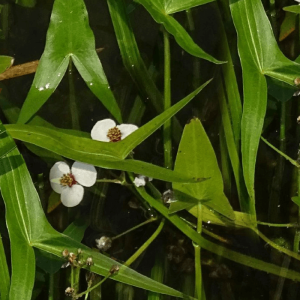Home " Oxygen plants " Arrowweed
TL;DR | Arrowweed (Sagittaria sagittifolia) is a striking aquatic plant with distinctive arrow-shaped leaves and white flowers with a purple centre. This native species is ideal for natural ponds and marsh zones where the water is stagnant or slow-flowing. The plant contributes to biodiversity and thrives in a sunny spot in nutrient-rich, shallow water.
Order easily via our partner: Order Arrowweed at Pond Master.
Arrowweed is a robust and native aquatic plant that can grow up to 90 cm tall. The plant immediately stands out because of its sharply pointed, arrow-shaped leaves that protrude above the water. These leaves grow on elongated stems that emerge from a root rosette. In fast-flowing water, the leaves remain long and ribbon-shaped, but in calmer water the typical arrow shapes form that give the plant its name.
From June to September, Arrowweed blooms with striking, white flowers arranged in whorls of three one above the other on an erect stem. The upper whorls consist of male flowers with striking purple stamens, while the lower whorls bear female flowers.
Order easily via our partner: Arrowweed order from Pond Master.
Arrowweed prefers to grow in shallow, stagnant or slow-flowing freshwater. Think of ditches, puddles, ponds and marsh zones. The plant roots firmly in silty soils of sand, loam or clay. It prefers a sunny spot, with a planting depth of between 20 and 40 cm. In too deep or fast-flowing water, Arrowweed rarely blooms.
Thanks to its preference for clean, fresh water without salt or pollution, the occurrence of Arrowweed is often an indication of a healthy aquatic environment. Arrowweed does well in clear groundwater rich in minerals and iron, especially when it is slightly alkaline in nature.
Arrowweed is of great ecological importance. The plant provides hiding places for insects and young amphibians. The flowers are attractive to insects, while the submerged parts contribute to the oxygen content of the water. The tubers on the offshoots also serve as a food source for water birds.
Arrowweed is hardy and emerges each spring from its underground tubers. During autumn and winter, the above-ground parts die off. It is advisable to remove dead leaves and stems to maintain water quality.
In ponds with sufficient nutrients, this species grows fine without additional fertilisation. In nutrient-poor ponds, occasional plant food or clay tablets can be used to stimulate growth.
Note: Be alert to confusion with the non-native Broad arrowhead (Sagittaria latifolia), which is very similar in appearance to the native species. The latter has broader leaves and all-white flowers. If you encounter this invasive species, it is wise to report it to the Dutch Food and Consumer Product Safety Authority (NVWA).
Arrowweed fits perfectly into ponds designed with ecology in mind and a natural look. Preferably place the plant in a pond basket or directly in the bottom in a place where the leaves can protrude well above the water.
Thanks to its graceful appearance and long flowering period, Arrowweed is also an attractive addition in ornamental ponds with marsh zones or riparian edges.

Bankweed can be ordered through our sales partner Vijvermeester.nl.
Zuurstofplanten.net is a website of Dutch Water Tech. Specialist in water treatment for municipalities and water boards. Would you like to know more? Visit dutchwatertech.co.uk for more information on our projects.
Dutch Water Tech BV
Gateway 1
4613 BW Bergen op Zoom
You can buy oxygen plants, bank plants and other pond products through our partner Vijvermeester.nl.
© 2025 Dutch Water Tech. All rights reserved.